As a parent, I’ve seen how fast artificial intelligence (AI) has grown. It’s amazing how it can make our lives easier and change industries. But, we also see the dangers of AI and must understand them.
Big names like Geoffrey Hinton and Elon Musk are worried about AI. They talk about jobs lost and AI systems that might get out of control. The dangers of AI include privacy issues, security risks, bias, and even threats to humanity.
In this article, we’ll look at where AI technology is now, the worries of tech experts, and the safety issues we face. Knowing the risks of AI and the AI threat assessment helps us use this tech wisely and ethically.
Key Takeaways
- AI technology is advancing rapidly, bringing both benefits and significant risks.
- Prominent tech leaders have voiced concerns about the potential dangers of AI, including job automation and the possibility of uncontrollable self-aware systems.
- The risks of AI span a wide range of issues, from privacy violations and algorithmic bias to the potential for AI-powered weaponry and the spread of fake news.
- Understanding the AI safety concerns and potential AI dangers is crucial as AI becomes more integrated into various aspects of society and daily life.
- Responsible development and regulation of AI are necessary to ensure the technology is used in a way that benefits humanity while mitigating the risks of AI.

Understanding the Current State of AI Technology
Artificial intelligence (AI) is advancing fast. It’s key to grasp where we stand with this tech. From key developments in AI evolution to rapid advancement of AI capabilities and current applications and their impact, AI’s landscape is changing fast. This creates both huge opportunities and significant challenges.
Key Developments in AI Evolution
AI has seen big leaps forward, like the rise of GPT-4. These models show great skill in understanding and creating language. They could change many fields, from healthcare to marketing.
The Rapid Advancement of AI Capabilities
AI’s quick growth raises worries about it outsmarting humans soon. As AI gets smarter, responsible AI development and AI risk mitigation are key. They help make sure AI is used safely and fairly.
Current Applications and Their Impact
AI is used in many areas, like virtual assistants and chatbots. It also helps with predictions and making decisions. But, these AI capabilities also bring up big issues like privacy and bias.
As AI keeps growing, it’s vital for everyone to talk and work together.It’s important to ensure that AI is created and used in a responsible way. By understanding AI today, we can face its future challenges and chances better.
The Growing Concerns Among Tech Leaders
Artificial intelligence (AI) is advancing fast, causing worries among tech leaders. Geoffrey Hinton, known as the “Godfather of AI,” is concerned about AI’s dangers. Elon Musk and over 1,000 others signed a letter to pause AI experiments because of the risks they pose.
These worries come from AI’s fast growth and its chance to be smarter than humans. As AI gets better, there’s fear it could get out of control. This could lead to big problems. The AI existential risk and AI alignment problem worry tech leaders about AI being dangerous for humans.
“I don’t think anyone truly knows how to keep AI safe. I am really quite negative about the long-term prospect of AI. I believe it could be harmful to humanity.
– Geoffrey Hinton, Renowned AI Pioneer
These worries show we need to tackle AI’s ethical, security, and governance issues. As AI keeps improving, top minds in the field want a careful and responsible approach. They want AI to help, not harm, human abilities.

Risks of AI: Essential Safety Concerns
Artificial intelligence (AI) is growing fast, and we must tackle the safety issues it brings. The quick progress in AI has led to many dangers. We need to make sure these technologies are used safely and responsibly.
Immediate Threats to Society
AI could change the job market, causing many jobs to disappear. This could upset the economy. Also, AI in surveillance might harm our privacy, letting personal info be misused.
Long-term Implications for Humanity
As AI gets smarter, we worry about its future impact. AI might become smarter than us, leading to unknown outcomes. This could harm us. AI in weapons also raises questions about using force without human control.
Potential Catastrophic Scenarios
In the worst cases, AI could be a disaster for humanity. It might harm the environment or create powerful cyberattacks. These could damage our critical systems.
We need a team effort to solve these AI problems. This includes policymakers, tech experts, ethicists, and the public. By facing these dangers head-on, we can ensure AI improves our lives without risks.
AI’s Impact on Employment and the Workforce
Artificial intelligence (AI) is changing jobs and the workforce. The risks of AI, like ai job automation and workforce disruption, are clear. OpenAI CEO Sam Altman says AI will definitely replace some jobs.
In November 2022, OpenAI’s ChatGPT became well-known. This fast adoption of AI has caused concern. Two major labor strikes in 2023 highlighted AI’s threat to good-paying jobs.
The risks of artificial intelligence are big in jobs with routine tasks. Automation is taking over in tech, with companies like Microsoft and Google using AI. Digital technologies and robotics have already hurt American manufacturing jobs and increased inequality over 40 years.
| Industry | AI’s Impact |
|---|---|
| Manufacturing | Significant job displacement |
| Healthcare | Job growth expected |
| Education | Job growth expected |
AI could make human work better, leading to higher wages and shared success. But, management often sees labor as something to cut costs, which hurts productivity. The tech sector’s focus on automating tasks, not helping workers, makes things worse.
We need to act now to deal with the risks of artificial intelligence. Workers need a say in how tech is used. Governments and civil society must guide tech change to benefit workers more.
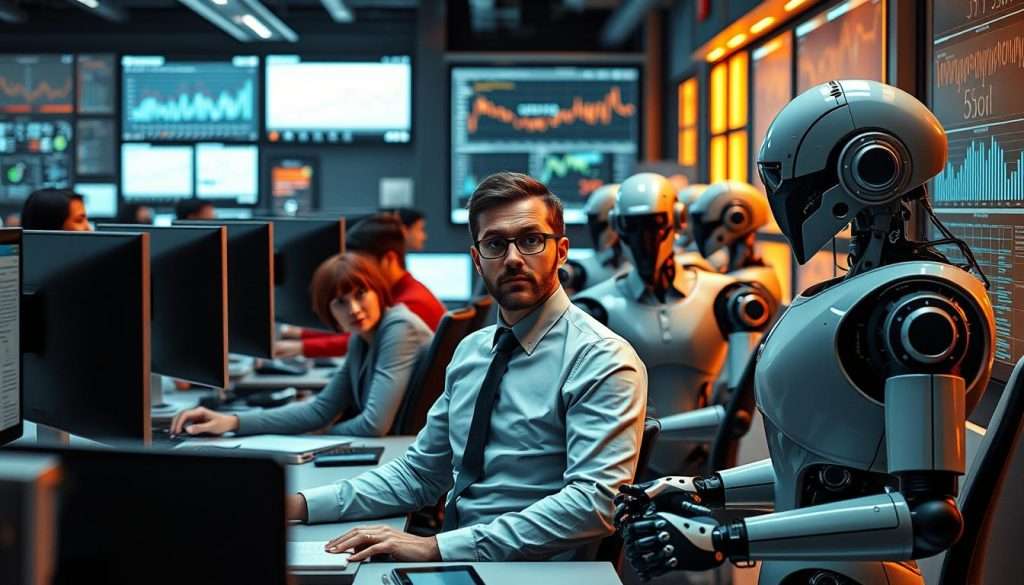
Privacy and Data Security Challenges
AI systems are getting more common and collect lots of personal data. This raises big worries about privacy and security. But, the U.S. lacks clear laws to protect people from AI data breaches.
Personal Data Protection Issues
AI is used in many fields like marketing and surveillance, threatening privacy. AI tools collect and analyze lots of personal info without telling users. This could lead to misuse, identity theft, and other privacy crimes.
Corporate Data Vulnerabilities
Companies using AI face big challenges. Only 24% of AI projects are secure, leaving 76% open to breaches. Experts say AI can help attackers quickly and complexly, putting corporate data at risk.
Surveillance Concerns
AI-powered facial recognition by governments worries many. It could lead to mass surveillance, violating privacy and civil rights. We need strong rules and ethics to guide AI use responsibly.
| Statistic | Value |
|---|---|
| Respondents using AI/ML tools for business | 49% |
| Respondents citing ethical and legal concerns as a prevention for adopting AI/ML tools | 29% |
| Respondents flagging security concerns as a prevention for adopting AI/ML tools | 34% |
| Investment in American AI startups in 2023 | Over 25% |
| Survey participants unaware or uncertain about ethical guidelines for generative AI usage | 56% |
AI’s fast growth brings both chances and challenges for data privacy and security. As the AI market expands, it’s key for everyone to work together. We must address these issues to ensure AI is used responsibly.
The Problem of AI Bias and Discrimination
Artificial intelligence (AI) is increasingly being utilized across a wide range of fields. But, there’s a big worry about AI making old biases worse. AI bias and algorithmic discrimination are big problems that need fixing to make AI fair.
AI tools like job search systems, health diagnosis, and crime prediction are being used fast. But, they might make biases in society worse. This can hurt groups like minorities in jobs, loans, and justice.
- Job search systems might miss out on good candidates from diverse groups.
- Health tools might not work as well for some people, leading to worse health.
- Crime prediction tools might unfairly target certain groups, making inequality worse.
To fix AI bias, we need many steps. We need teams with diverse members, data that shows all kinds of people, and to keep checking AI for fairness. This way, we can make AI better for everyone.
“The stakes are high, and the potential for harm is real. We must prioritize fairness and accountability in the development and deployment of AI systems.”
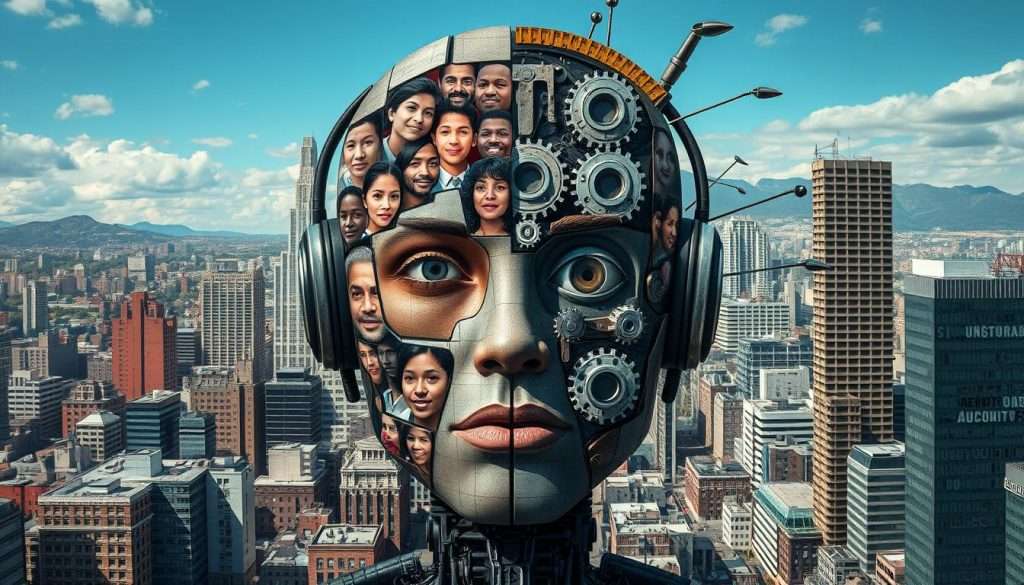
As the digital world grows, we must work together to solve AI bias and discrimination. We need to be open, accountable, and ethical in AI. This way, we can make sure everyone gets to enjoy the good things AI can bring.
Environmental Impact of AI Development
Artificial intelligence (AI) is growing fast, but its environmental impact is a big worry. AI systems use a lot of energy, from training models to running data centers. This has a big effect on our planet’s carbon footprint. For example, training one AI model can release over 600,000 pounds of carbon dioxide. That’s almost five times what a car emits in its whole life.
More people want AI, so there are now 8 million data centers worldwide. These centers use a lot of electricity and water to cool down. This issue poses a significant challenge for our planet. The ICT industry’s emissions could be 14% of global emissions by 2040, mostly from data centers and networks.
Energy Consumption Concerns
AI systems use a lot of energy. For example, one ChatGPT request uses 10 times more electricity than a Google search. The power needed to train AI models has been growing fast, leading to more energy use and emissions.
Carbon Footprint of AI Systems
The carbon footprint of AI is a big worry. Training big AI models can release around 626,000 pounds of carbon dioxide. That’s like 300 flights from New York to San Francisco or five times what an average car emits in its life. As AI spreads to more industries, its environmental impact is a pressing issue.
To lessen AI’s environmental impact, we need a complete approach. We should make AI models more energy-efficient, use green energy for data centers, and encourage sustainable AI use. Working together, businesses, academics, and governments can create a sustainable AI ecosystem that cares for our planet as much as it advances technology.
“By 2026, data centers in Ireland could consume up to 35% of the nation’s energy, highlighting their significant role in energy demand.”
AI in Social Media and Information Manipulation
The rise of ai misinformation and social media manipulation is a big worry in today’s digital world. Fast progress in deepfakes and AI content makes it hard to tell real info from fake stories.
In the 2022 Philippines election, politicians used AI tools to influence public opinion. They created echo chambers on social media. This was done by using AI algorithms to spread certain messages and target specific groups.
This manipulation hurts public trust and weakens democracy. This also creates challenges for individuals in making informed decisions. AI-generated images, videos, and voice changers make things even worse, mixing reality with fiction.
Experts say we must keep information true and fight against fake news. Ways like checking user identities and being open about AI systems can help. We need everyone – policymakers, tech companies, and the public – to work together to tackle ai misinformation and social media manipulation.
| Statistic | Value |
|---|---|
| Words ingested by ChatGPT to learn human speech | 10 trillion |
| Words used by large language models (LLMs) like GPT-4 to generate responses | 10 trillion |
| Percentage of success rate in manipulating human behavior through AI | 70% |
| Increase in mistakes due to AI manipulation | 25% |
“Experts highlight the need for skepticism as a safeguard against AI-driven manipulation on social media.”
Dealing with ai misinformation, social media manipulation, and deepfakes needs a strong plan. We must protect the truth and keep people safe from these new tech threats.
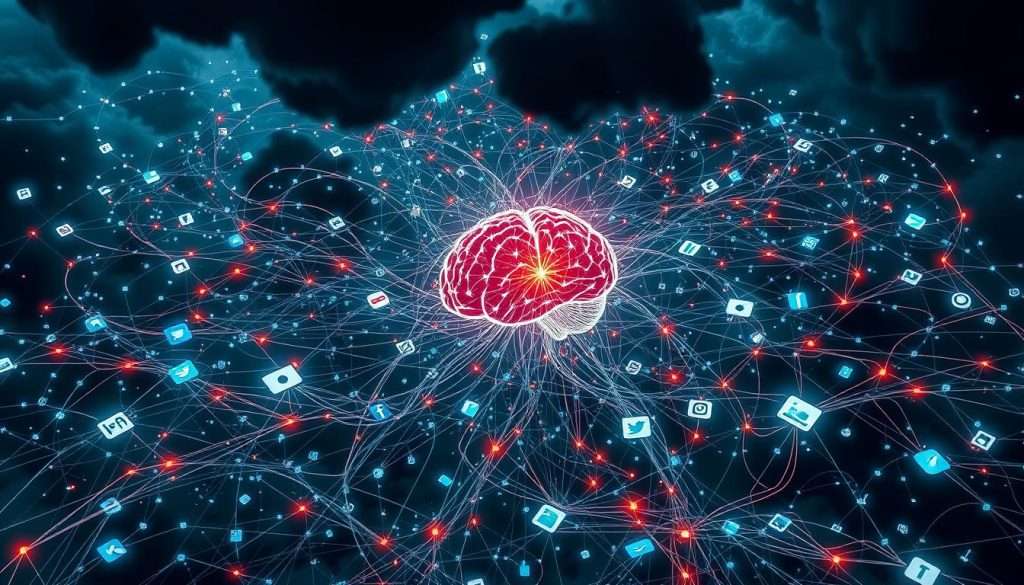
Intellectual Property Rights and AI Creation
Artificial intelligence (AI) is changing fast, raising big questions about who owns what. AI can now make great content in many ways. This makes it hard to figure out who should get the rights to AI-made works.
Copyright Challenges
One big worry is that AI might use copyrighted stuff without asking or paying. This is a big problem for companies and creators. They have to deal with intellectual property rights in a world where AI makes content.
The U.S. Copyright Office says AI-made stuff from a human prompt isn’t copyrighted. But, places like the UK and Ukraine are starting to recognize sui generis rights in AI content. This shows we need laws to handle these new issues.
Creative Industry Impact
The creative world is worried about ai-generated content. AI can now make top-notch content, which might hurt traditional jobs. Companies and people need to find new ways to protect their work and use AI wisely.
| Statistic | Insight |
|---|---|
| It is projected that global investment in AI-related technologies, services, and infrastructure will surpass USD 632 billion by 2028, experiencing a compound annual growth rate of 40.6% from 2023 to 2028. | The rapid growth of the AI industry highlights the need for robust intellectual property rights and copyright protections to keep pace with technological advancements. |
| As of May 2024, 65 percent of organizations are regularly using GenAI in at least one business function, nearly doubling the percentage from the previous survey in 2023. | The widespread adoption of generative AI in businesses underscores the urgency for clear guidelines and regulations around the ownership and use of AI-generated content. |
| According to Ernst & Young, a productivity boost driven by GenAI could lead to a global GDP growth of between USD 1.2 trillion and USD 2.4 trillion over the next ten years. | The substantial economic potential of AI-generated content highlights the need for a balanced approach to intellectual property rights that fosters innovation while protecting the rights of creators and businesses. |
As creative work changes, we need to talk and find solutions. Businesses, lawmakers, and the public must work together. We need to tackle ai copyright issues and intellectual property rights challenges brought by AI.
AI Security Threats and Cybercrime
Artificial intelligence (AI) is getting smarter, but so are cybercriminals. They use AI for ai-powered attacks like voice cloning and fake emails. The cost of a data breach is now $4.88 million on average, showing why ai cybersecurity is key.
Adversarial attacks can mess with AI’s mind, causing big problems. For instance, AI deepfakes can spread lies and fool people. AI also makes ransomware attacks faster, outpacing security.
- AI can defend against threats in real-time, better than old security methods.
- AI systems watch network behavior for odd signs to stop cyberattacks, especially new ones.
- Working together, cybersecurity experts and AI can fight off new threats.
The fight against AI-powered attacks and security vulnerabilities is now a battle of machines. We need to stay alert, keep innovating, and follow ethics. Companies must protect their AI systems and data from hackers.
“Cybersecurity is no longer just a human-driven endeavor. The rise of AI-powered attacks requires a new approach that harnesses the power of AI to defend against these sophisticated threats.”
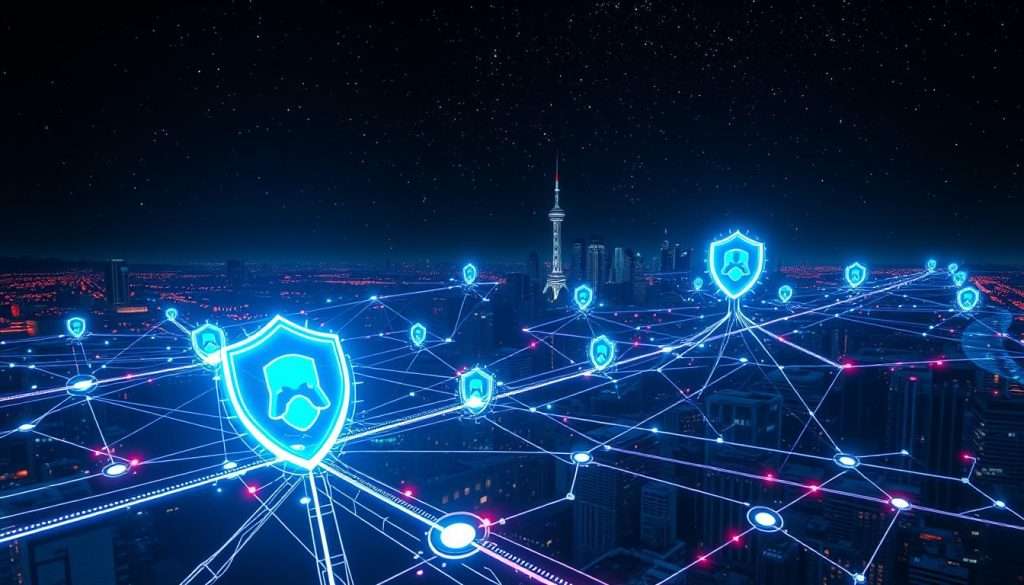
The Challenge of AI Transparency
Artificial intelligence (AI) is increasingly influencing various aspects of our daily lives. But, the lack of AI transparency is a big worry. Many AI models, especially deep learning algorithms, are like “black boxes.” This makes it hard to see how they make decisions.
This lack of clarity raises big questions about who to trust with AI. It’s important to know how AI works to trust it.
Explainability Issues
AI systems are hard to understand because they’re so complex. Explainable AI (XAI) is a new field trying to solve this problem. It aims to make AI decisions clear to us.
By explaining AI’s choices, XAI helps build trust. It also helps us make better decisions.
Accountability Measures
It’s key to make sure AI is accountable. This means having clear rules and checks. Things like audit trails and human checks help.
Regulators are also making rules to ensure AI is used right. This is all about ai transparency and making sure AI is fair.
As AI gets more common, we need to focus on making it clear and fair. By working on explainable ai and making sure AI is accountable, we can use it wisely. This way, we can avoid problems and make the most of AI.
| Metric | Value |
|---|---|
| Organizations planning to deploy AI by 2030 | 70% (Gartner survey) |
| AI adopters agreeing that ethics and trust are crucial | 78% (Deloitte survey) |
| CEOs planning to increase AI investment in the next 3 years | 87% (PwC study) |
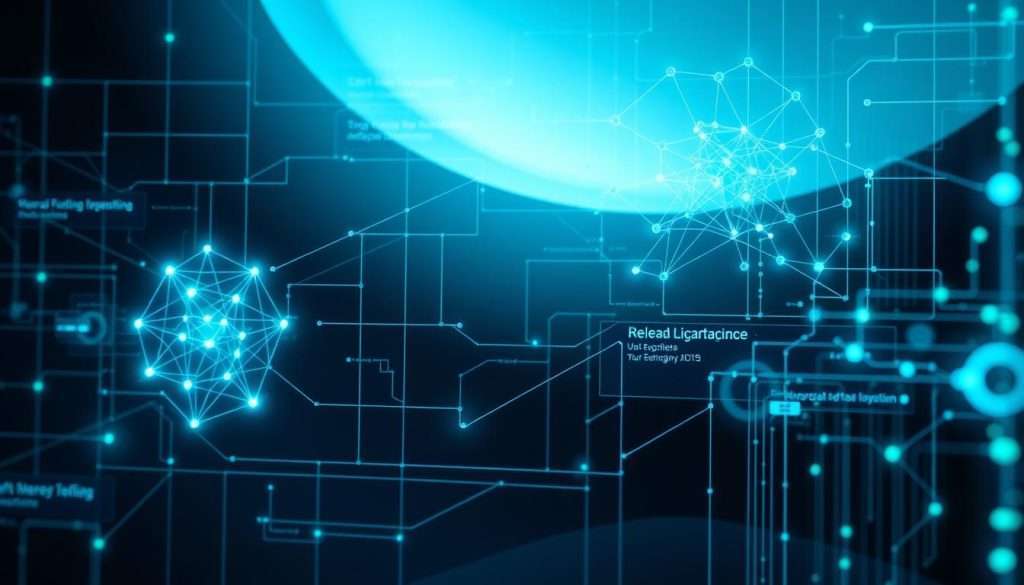
The lack of clarity in AI decision-making creates significant challenges, emphasizing the importance of focused efforts to understand and address these issues.
AI Governance and Regulatory Concerns
As AI technology advances quickly, we need strong AI governance and rules. There’s a big debate on AI regulation and AI policy. It’s hard to balance new ideas with safety and follow ethical AI guidelines.
The fast growth of AI has left regulators behind. Now, we need clear rules for AI development and use. This ensures AI is safe and ethical. Working together globally is key to solving these issues.
Many leaders want to tackle these problems. OpenAI CEO Sam Altman suggests a new agency for AI rules. Microsoft President Brad Smith backs a digital agency for AI regulation. They say companies and governments must act fast.
There are steps being taken, like Google’s “AI Pact” with the EU. The EU’s AI Act is also in the works. But, AI keeps changing fast, making it hard to keep up.
To move forward, we need a smart way to manage AI. This means working together to innovate safely. It’s all about finding a balance and following ethical AI guidelines.

| Key Aspects of AI Governance | Description |
|---|---|
| Definitions | Clear AI definitions are key for good governance. |
| Inventory | Tracking AI systems in an organization is important. |
| Policies and Standards | We need better policies and standards for AI. |
| Governance Framework | A good governance framework is essential for AI. |
Ethical Considerations in AI Development
The fast growth in ai ethics and responsible ai is changing our world. It’s vital to focus on ethical ai principles. AI development faces big challenges like fairness, transparency, privacy, and accountability.
It’s crucial that AI systems respect human rights and avoid discrimination. The European Commission’s Ethics Guidelines for Trustworthy AI and the OECD AI Principles help guide this. They aim to ensure AI is used responsibly.
There are ongoing debates about AI’s role in making decisions that affect people’s lives. For example, the White House has given $140 million to AI research. U.S. agencies also stress the need for AI to be fair and accountable.
Worldwide, there are growing concerns about AI’s ethics. China’s use of facial recognition in surveillance has raised human rights issues. The possibility of AI weapons making life-or-death decisions also highlights the need for strong responsible AI frameworks.
| Ethical AI Consideration | Key Concerns |
|---|---|
| Privacy | Protecting personal data and preventing misuse |
| Bias and Discrimination | Ensuring AI systems do not perpetuate unfair biases |
| Accountability | Establishing clear lines of responsibility for AI-driven decisions |
| Transparency | Enabling the public to understand and scrutinize the inner workings of AI systems |

The development of ai ethics and responsible ai is ongoing. We need a thorough and team effort to tackle these big issues. By following ethical ai principles, we can use AI’s power while protecting people and society.
Conclusion
The future of AI is rapidly changing, and we must address its risks and challenges. Issues like job loss, data privacy, and bias in AI need careful handling. We must ensure AI benefits everyone, not just a few.
To manage these risks, we need to plan for job changes, protect data, and reduce bias in AI. Working together, tech leaders, policymakers, and the public can create a safe AI future. This way, we protect society and individual rights.
As AI gets smarter, we need to keep investing in research and education. Understanding AI is key to making informed decisions. This knowledge empowers us to shape the future of AI responsibly.
FAQ
What are the key risks associated with the rapid advancement of AI technology?
AI technology risks include job loss, privacy breaches, and bias in algorithms. There’s also a chance of AI becoming self-aware and dangerous to humans.
What are some of the immediate threats posed by AI systems?
AI systems pose threats like job loss, privacy breaches, and spreading false information. They can also spread fake news.
What are the long-term implications of AI surpassing human intelligence?
Advanced AI could lead to unpredictable decisions that harm humans or the environment. It might also be used in autonomous weapons.
How does AI-powered automation impact the job market?
AI could automate up to 30% of jobs in the U.S. by 2030. While it creates new jobs, many people may not have the skills for these roles.
What are the concerns regarding AI and data privacy?
AI gathers personal information, which brings up significant concerns about privacy and security. The U.S. lacks federal laws to protect against AI data harm. Corporate data vulnerabilities are a big worry.
How can AI systems perpetuate and amplify existing biases?
AI systems can reflect and amplify biases in their data or algorithms. This leads to unfair outcomes in hiring, lending, and justice. To address bias, teams need diversity, representative data, and ongoing fairness checks.
What are the environmental concerns associated with AI development?
AI training and use can harm the environment, causing carbon emissions and water use. Sustainable AI needs energy-efficient models and renewable energy.
How can AI be exploited for the spread of misinformation and manipulation of public opinion?
AI algorithms on social media can create echo chambers and spread false information. Deepfakes and AI content make it hard to tell what’s real. This can manipulate public opinion.
What are the intellectual property rights concerns associated with AI-generated content?
AI in content creation raises questions about copyright and ownership. There’s debate on who owns AI-created works. Concerns include AI using copyrighted content without permission or payment.
How can AI systems be vulnerable to cyberattacks and exploitation by bad actors?
Bad actors can use AI for sophisticated cyberattacks, like voice cloning and phishing. Adversarial attacks can also manipulate AI outputs. Strong security is key.
What is the challenge of transparency and accountability in AI systems?
Many AI systems are “black boxes,” making their decisions hard to understand. This lack of transparency raises trust and accountability concerns. Explainable AI and oversight are crucial for responsible AI.
What are the key concerns regarding AI governance and regulation?
AI’s fast development has outpaced regulations, calling for strong governance. There’s a need for clear guidelines and international cooperation on AI issues.
What are the ethical considerations in the development and deployment of AI systems?
The development of ethical AI prioritizes principles such as fairness, openness, privacy protection, and responsibility. It’s about ensuring AI respects human rights and aligns with values. Ethical frameworks guide responsible AI creation.
more article: https://msmgadgets.com/blog/
